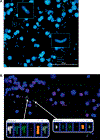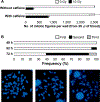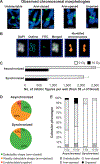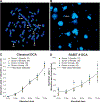RABiT-II-DCA: A Fully-automated Dicentric Chromosome Assay in Multiwell Plates
- PMID: 31295087
- PMCID: PMC8567107
- DOI: 10.1667/RR15266.1
RABiT-II-DCA: A Fully-automated Dicentric Chromosome Assay in Multiwell Plates
Abstract
We developed a fully-automated dicentric chromosome assay (DCA) in multiwell plates. All operations, from sample loading to chromosome scoring, are performed, without human intervention, by the second-generation Rapid Automated Biodosimetry Tool II (RABiT-II) robotic system, a plate imager and custom software, FluorQuantDic. The system requires small volumes of blood (30 µl per individual) to determine radiation dose received as a result of a radiation accident or terrorist attack. To visualize dicentrics in multiwell plates, we implemented a non-classical protocol for centromere FISH staining at 37°C. The RABiT-II performs rapid analysis of chromosomes after extracting them from metaphase cells. With the use of multiwell plates, many samples can be screened at the same time. Thus, the RABiT-II DCA provides an advantage during triage when risk-based stratification and medical management are required for a large population exposed to unknown levels of ionizing radiation.
Figures







Similar articles
-
The RABiT-II DCA in the Rhesus Macaque Model.Radiat Res. 2020 Nov 1;196(5):501-509. doi: 10.1667/RR15547.1. Radiat Res. 2020. PMID: 33022052 Free PMC article.
-
Validation of a High-Throughput Dicentric Chromosome Assay Using Complex Radiation Exposures.Radiat Res. 2023 Jan 1;199(1):1-16. doi: 10.1667/RADE-22-00007.1. Radiat Res. 2023. PMID: 35994701 Free PMC article.
-
THE DECADE OF THE RABiT (2005-15).Radiat Prot Dosimetry. 2016 Dec;172(1-3):201-206. doi: 10.1093/rpd/ncw172. Epub 2016 Jul 13. Radiat Prot Dosimetry. 2016. PMID: 27412510 Free PMC article.
-
Cytogenetic damage analysed by the dicentric assay.Ann Ist Super Sanita. 2009;45(3):251-9. Ann Ist Super Sanita. 2009. PMID: 19861729 Review.
-
The micronucleus assay in radiation accidents.Ann Ist Super Sanita. 2009;45(3):260-4. Ann Ist Super Sanita. 2009. PMID: 19861730 Review.
Cited by
-
Nuclear and Radiological Emergencies: Biological Effects, Countermeasures and Biodosimetry.Antioxidants (Basel). 2022 May 31;11(6):1098. doi: 10.3390/antiox11061098. Antioxidants (Basel). 2022. PMID: 35739995 Free PMC article. Review.
-
Sex differences in radiation research.Int J Radiat Biol. 2024;100(3):466-485. doi: 10.1080/09553002.2023.2283089. Epub 2023 Nov 27. Int J Radiat Biol. 2024. PMID: 37991728 Free PMC article.
-
Plasma levels of serum amyloid A1 and mortality after exposure to high-dose radiation.Ann Transl Med. 2020 Jun;8(11):661. doi: 10.21037/atm.2020.03.172. Ann Transl Med. 2020. PMID: 32617281 Free PMC article. No abstract available.
-
The RABiT-II DCA in the Rhesus Macaque Model.Radiat Res. 2020 Nov 1;196(5):501-509. doi: 10.1667/RR15547.1. Radiat Res. 2020. PMID: 33022052 Free PMC article.
-
RENEB Inter-Laboratory Comparison 2021: Inter-Assay Comparison of Eight Dosimetry Assays.Radiat Res. 2023 Jun 1;199(6):535-555. doi: 10.1667/RADE-22-00207.1. Radiat Res. 2023. PMID: 37310880 Free PMC article.
References
-
- Cytogenetic dosimetry: Applications in preparedness for and response to radiation emergencies. EPR-Biodosimetry 2011; Vienna: International Atomic Energy Agency; 2011.
Publication types
MeSH terms
Grants and funding
LinkOut - more resources
Full Text Sources

